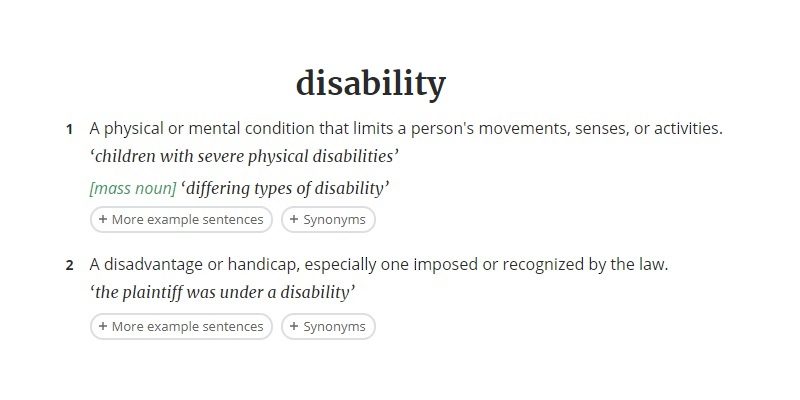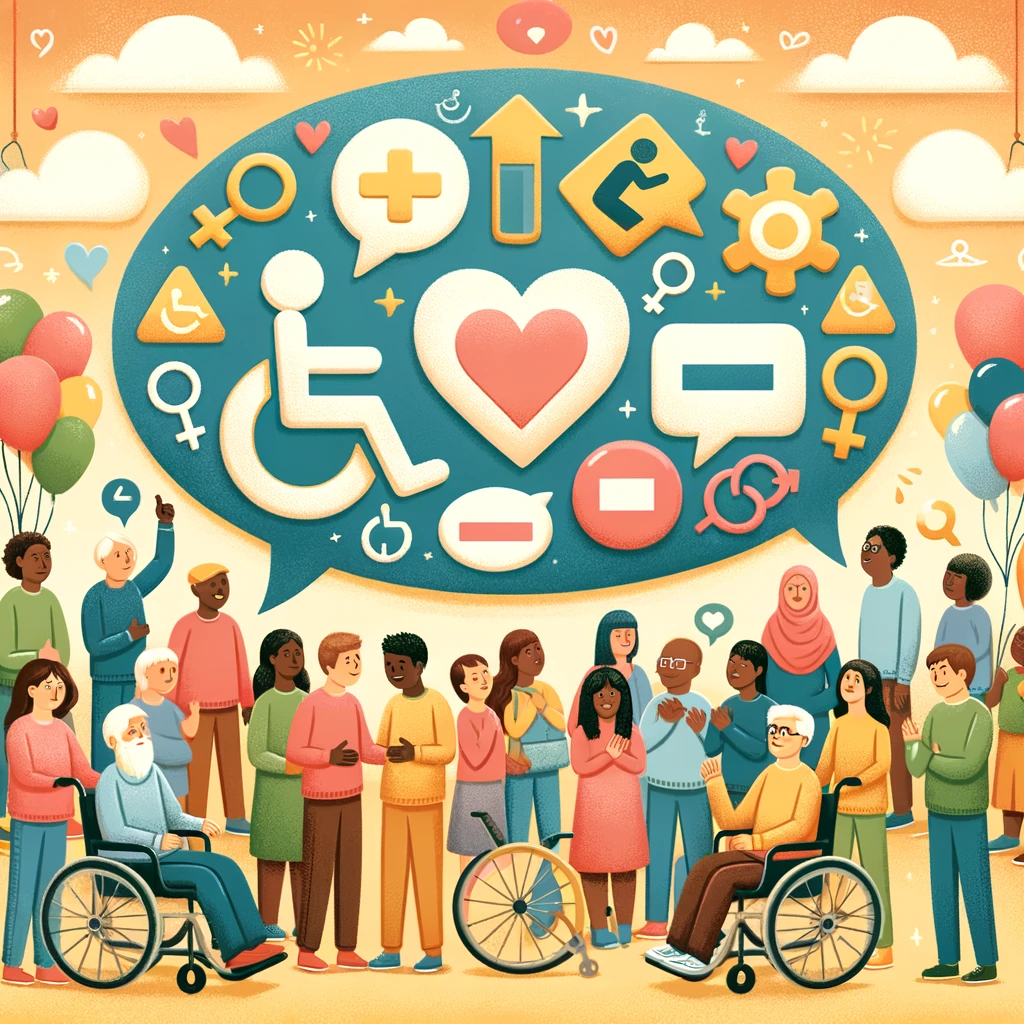Throughout history and generations, people with disabilities have been referred to in many different ways. Even in today’s society and media, there remains disagreement and misunderstanding about which words and phrases are acceptable and which are absolutely not.
Our writer Emma Purcell explored the definitions, origins and acceptability of different disability terms, and how they make her and other disabled people feel today.
Read on to find out what she thinks, and let us know what you think by leaving a comment at the bottom of the article, messaging us on Facebook, or tweeting us. translation:.
Unacceptable words and phrases
handicapped
Disabled is a term used to describe someone with a physical or mobility impairment. The Oxford English Dictionary (OED) defines it as “someone who is unable to walk or move properly because of a disability or injury to their back or legs.”
The word was first used around 950 AD to describe someone who was unable to walk due to an illness or disability. By the 20th century, cripple had come to be considered an insult.
Today, it is considered acceptable for disabled people to identify themselves as disabled and to make fun of it.
Although they would be offended if a non-disabled person or a stranger called them “disabled,” they are happy to use the term among their peers in a humorous way.
Delay
“Retard” is a word that was used in the 15th century to describe someone with an intellectual disability and a slow learner. Today, it is seen as an insulting term to describe someone with a learning disability or behavioral problems.
It comes from the Latin verb “retardo” meaning “to delay,” which in turn comes from the root “tardus” meaning “slow” or “slow.”
This is one of those statements I strongly disagree with – everyone has their own way of thinking and learning, and no one should feel inferior for it.
handicapped
The OED describes a disabled person as “a person who has a condition that significantly limits their ability to function physically, mentally, or socially.”
The term was first recorded in the 20th century after a writer used the phrase “handicapped children.” It remained in standard British English use until the 1980s, and is still used today in the United States when referring to handicapped access and handicapped parking.
I first learned this term when I used the voice function on my phone to select an emoji for a disability logo, which was called “disability sign.”
I find this absolutely distasteful. By definition, a person with a disability is defined as being unable to carry out everyday tasks and having limited access to education, employment, leisure, and relationships. In some cases, social barriers put in their way mean they may not have access to these things. But we absolutely should.
Special Needs
Special needs is a term usually associated with health and social care professionals. It is used in places such as schools, care homes, medical facilities, clubs and associations to describe groups of people with disabilities.
The term arose as an attempt to avoid more negative representations of children with disabilities by labeling their educational needs rather than their condition. In my opinion, people with special needs represent a group of people who are not welcomed, accepted or ridiculed.
In 2010, when I was 16, I went to a school for people with disabilities. Around that time, the school was certified as a “special” specialist school. I felt that was derogatory and insulting to the students. Don’t get me wrong, the school was great and met my needs perfectly. But I would never want us to be labelled as a special school. Instead, the school should be known as a specialist in “accessible education” or “supportive education”.
Inspiration
Inspiration is defined by the OED as “the process of being mentally stimulated to do or feel something, especially to do something creative.” For example, this could mean a successful writer inspiring his readers to become writers, or a famous musician inspiring his fans to become performers. It comes from the Middle English phrase “divine teaching” and the Old French Latin “inspiration.”
However, for many people with disabilities, the word “inspiration” is considered condescending, frustrating and unacceptable.
Many non-disabled people find it inspiring to see someone with a disability accomplish everyday tasks like getting out of bed, cooking, or leaving the house. But we just go about our lives like everyone else. Just because we use a wheelchair, mobility aid, cane, hearing aid, or other assistive device doesn’t mean we’re inspiring.
Acceptable Words and Phrases
Intellectual disability
Intellectual disability is another name for a learning disability. According to the American Association on Intellectual and Developmental Disabilities, intellectual disability is defined as “a disability that involves significant limitations in both intellectual functioning (reasoning, learning, problem solving) and adaptive behavior, encompassing a range of everyday social and practical skills.”
This phrase has become popular in the 21st century. In my opinion, it indicates that people with this type of disability are not stupid, but just need support to perform certain tasks such as reading, writing, calculating, and communicating.
Neurodiversity
Neurodiversity is a term that emerged in the late 20th century and is defined as “the diversity and differences in neural structure and function that exist among human beings, especially when viewed as normal and natural rather than pathological.” It is usually associated with autism, but also with conditions such as dyspraxia, dyslexia, and ADHD.
This does not mean that people with disorders such as autism have brain damage and are ill, but rather that they have neurological differences that should be respected like any other human diversity.
They look different
Looking different refers to someone who has a facial or physical defect, such as a bilateral cleft lip. This is a much more polite way of saying they are disfigured. They don’t have a physical defect, but they are different in shape, size, or color from other people.
Creative
I came across this phrase on a blog called CreativelyAble and thought it was a great phrase to describe someone with a disability. The blogger, Larree Carnes, is from Los Angeles and has been blogging for a few months now. She became ill and disabled in 2004.
She told me, “I came up with this idea because I had to get creative in so many ways: shopping (for example, adding a makeshift cart to the back of my scooter), doing chores around the house (like adding an extension pole to pick fruit from the trees or clean windows), being a mom for my son’s team at sporting events (I have a hand disability, but I had to bring snacks and cut oranges for the team, among other things).”
That’s why I say ‘creative’ and not ‘disabled.'”
invalid
Finally, the word “disabled.” Most people use this word, but some try to avoid it.
The OED defines it as “having a physical or mental condition that limits (a person’s) movement, senses, or activity.” For me, I have no qualms about using this expression, as long as it’s used in the right context.
I prefer the “disabled” approach – for example, “I’m Emma and I’m disabled” or describe my condition as “I’m Emma and I have cerebral palsy and I’m registered blind”. I think it’s important to say the name first – talk about the disabled person, not the disability.
If the situation is not relevant to my disability, such as a job search or news report, I will simply say, ‘My name is Emma and I am a graduate student looking for work in the media industry.’ I will only disclose my disability if it is a disability-related article or a disability-related media platform, or if I am asked about my disability.

 What do you think about these words about disability?
What do you think about these words about disability?
Overall, everyone has their own preferences for how to call or describe disabilities, but I think it’s important when communicating with people with disabilities to first be interested in their skills, experiences, hobbies, and personality, and then, if requested and allowed by the person, talk about their disability or condition.
If you want to learn more about disability terminology, I highly recommend reading Guidelines for Disability Writing and Journalism and Patriarchy in the UK: The Language of Disability.
Emma Purcell
To find out more about Emma, check out her blog, Rock For Disability.
I’d love to know your thoughts on these words and phrases. Leave a comment at the bottom of the article, message me on Facebook, or tweet me. translation:.
Updated February 2024
Identity-First Language vs. People-First Language
Person-centered language (e.g., “people with disabilities”) aims to emphasize the humanity and individuality of people with disabilities, rather than defining them by their disability. It grew out of the advocacy movement of the 1970s. However, some disability advocates argue that person-centered language implies that disability itself is negative and should be separated from a person’s identity. This has led more recently to the emergence of identity-centered language (e.g., “people with disabilities”), which recognizes disability as an integral experience that shapes a person’s identity and perception of the world. There are sound arguments on both sides.
Benefits of human-centered language:
Prioritize the person rather than the disability. Avoid judging people solely on the basis of their disability. Help challenge the assumption that disability is inherently less human or dignified.
Disadvantages of human-centered language:
The need to distance disability from the person suggests that disability is negative Does not reflect people who see disability as central to their identity Allows disabled people to be treated as ‘other’, separate from wider society
Benefits of an identity-first language:
Acknowledge disability as a natural and valid experience Respect people who see disability as a core part of their identity Focus on societal barriers rather than inherent limitations of people with disabilities
Disadvantages of identity-first languages:
Some people may perceive disability as insensitive or too restrictive. There is a risk of overemphasizing disability as an individual characteristic.
Additionally, different disability communities have different preferences. Many in the deaf and autistic communities prefer identity-focused language, while conditions like diabetes and epilepsy may prefer person-focused language. When possible, ask individuals their preferences. Using both languages when appropriate demonstrates inclusivity and respect for diverse perspectives within the disability community.
Use respectful language
When discussing disability issues, it is important to use sensitive language that does not reinforce negative stereotypes. Words like “crippled,” once common, are now considered disrespectful and offensive by many in the disability community. Here are some respectful alternatives to using such problematic language:
“Disabled” / “People with mobility impairments” or “wheelchair users” “People who use wheelchairs” as another name for “physically disabled” Parking spaces and toilets are “accessible” instead of “handicapped” “Disabled” instead of “disabled” to emphasize the person first Avoid words that imply sympathy, such as “victim”, “suffering”, “wheelchair-bound”
Because the disability community itself is diverse, terminology preferences vary. When possible, ask individuals how they would like to be referred to. Using inclusive language shows respect and supports dignity for people with disabilities. The key is to focus on the individual, not the disability. Terminology should be descriptive, not emotive or judgmental. Thoughtful word choices can help eliminate bias and work toward equal recognition for people with disabilities.
Further information on inclusive language from governments and disability organizations
Below are some additional reliable resources on disability language and terminology:
UK Government Guidance: US Government Guidance: Disability Activist Groups:


